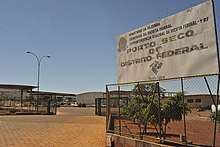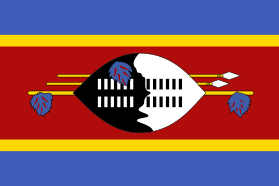Dry port
A dry port (sometimes referred to as an inland port) is an inland intermodal terminal directly connected by road or rail to a seaport, operating as a centre for the transshipment of sea cargo to inland destinations.[1]

In addition to their role in cargo transshipment, dry ports may also include facilities for storage and consolidation of goods, maintenance for road or rail cargo carriers and customs clearance services. The location of these facilities at a dry port relieves competition for storage and customs space at the seaport itself.[2]
A dry inland port can speed up the flow of cargo between ships and major land transportation networks, creating a more central distribution point. Inland ports can improve the movement of imports and exports, moving the time-consuming sorting and processing of containers inland, away from congested seaports.[2]
Background
The term inland port is used in a narrow sense in the field of transportation systems to mean a specialized facility for intermodal containers (standardized shipping container) in international transport. Rather than goods being loaded and unloaded in such ports, shipping containers can just be transferred between ship and road vehicle or ship and train. The container may be transferred again between road and rail elsewhere and the goods are only loaded or unloaded at their point of origin or final destination.[1][2]
Shipping containers allow some functions traditionally carried out at a seaport to be moved elsewhere. Examples are the functions of receiving, processing through customs, inspecting, sorting, and consolidating containers going to the same overseas port. Container transfer at the seaport can be sped up and container handling space can be reduced by transferring functions to an inland site away from the port and coast.[1][2]
Distribution can also be made more efficient by setting up a link between the inland site and seaport as, say, a high-capacity rail link with a lower unit cost than sending containers individually by road. The containers are still collected from their origins or distributed to their ultimate destinations by road with the transfer happening at the inland site.[1][2]
An inland port is just such an inland site linked to a seaport. This kind of inland port does not require a waterway. Key features of an inland port are the transfer of containers between different modes of transportation (intermodal transfer) and the processing of international trade. This differentiates an inland port from a container depot or transport hub.[3]
The term inland port may also be used for a similar model of a site linked to an airport or land border crossing rather than a seaport.
The definition of inland port in the jargon of the transportation and logistics industries is:
An inland port is a physical site located away from traditional land, air and coastal borders with the vision to facilitate and process international trade through strategic investment in multi-modal transportation assets and by promoting value-added services as goods move through the supply chain.[4]
Inland ports may also be referred to as dry ports or intermodal hubs.
Dry ports in Africa



































Dry ports in Asia





























Dry ports in Europe









.svg.png)
Dry ports in Latin America




Dry ports in North America
.svg.png)
.svg.png)
.svg.png)
.svg.png)









Dry ports in Oceania
.svg.png)
.svg.png)
.svg.png)
.svg.png)
.svg.png)
.svg.png)
.svg.png)
.svg.png)
.svg.png)
.svg.png)
.svg.png)
.svg.png)




References
- In Loc (January 2007). "Feasibility Study on the network operation of Hinterland Hubs (Dry Port Concept) to improve and modernise ports' connections to the hinterland and to improve networking" (PDF). InLoc. Archived from the original ((PDF) Archived from the Original) on 13 April 2008. Retrieved 20 November 2018.
- Dictionary of International Trade (20 November 2018). "What is a dry port? Definition and meaning". Global Negotiator. Retrieved 20 November 2018.
- C.M. (Red) Williams, President of Saskatchewan Agrivision Corporation. "Inland Port vs. Container Port" (PDF). Retrieved 27 July 2007.
- Leitner, Sara Jean; Harrison, Robert (2001). The Identification and Classification of Inland Ports. Center for Transportation Research, The University of Texas at Austin. p. 69. Archived from the original on 29 October 2013. Retrieved 24 October 2013.
- Railways Africa (3 December 2010). "Angolan Railway Serves Dry Port". Johannesburg: Railways Africa. Retrieved 20 November 2018.
- Comesa (2 June 2018). "Construction of a $300m Dry Port Commissioned on the DRC–Zambia Border". Lusaka, Zambia: COMESA. Retrieved 20 November 2018.
- Dorcas Kang'ereha (1 March 2018). "Ethiopian enterprise to construct four Dry Ports". Nairobi: Construction Review Online. Retrieved 20 November 2018.
- 2merkato.com (25 March 2009). "Dry Ports in Ethiopia". Addis Ababa: 2merkato.com. Retrieved 20 November 2018.
- Arthur-Mensah, Godwill (17 August 2018). "Government promises win-win for Boankra Inland Port project". Accra: Ghana News Agency. Retrieved 20 November 2018.
- Brendon Cannon (18 January 2018). "Inland Container Depots and the Future of Handling East Africa's Cargo". Nairobi: Kenyan Engineer.
- Andae, Gerald (15 January 2019). "Truckers cry foul over delays at Inland Container Depot". Business Daily Africa. Nairobi. Retrieved 16 January 2019.
- Editorial (2 July 2018). "The ICD project: Long walk to reality". Lagos: Nigeriamaritime360.com. Retrieved 20 November 2018.
- Mugisha, Ivan (18 November 2018). "Masaka ICD to open in January, cutting time and cost of imports to the region". The EastAfrican. Nairobi. Retrieved 19 November 2018.
- Koigi, Bob (14 November 2018). "DP World, Rwanda government unveils East Africa's first inland dry port hub". Haarlem, Netherlands: Africa Business Communities. Retrieved 16 January 2019.
- Erené Cronje, Marianne Matthee and Waldo Krugell (2009). "The Role of Dry Ports In South Africa" (PDF). Transport and Communications Bulletin for Asia and the Pacific. Retrieved 20 November 2018.
- Geoview.info (14 August 2011). "Matsapha Dry Port, Manzini, Swaziland". Geoview.info. Retrieved 20 November 2018.
- The Citizen Reporter (12 September 2013). "Isaka dry port project remains on track". The Citizen (Tanzania). Dar es Salaam. Retrieved 20 November 2018.
- Togo Invest (2017). "Cinkasse Dry Port". Lome: Togo Invest. Retrieved 20 November 2018.
- Joomlasupport (27 April 2009). ""President's Office Dipped Its Fingers In URA's Till"". The Obsrver (Uganda). Kampala. Retrieved 15 September 2019.
- Oluoch, Fred (1 November 2010). "Tororo dry port to begin operations by 2012". The EastAfrican. Nairobi. Retrieved 20 November 2018.
- The European Times (2011). "Filling the Transport-Infrastructure Gap". The European Times Magazine Online. Retrieved 20 November 2018.
- Business Reporter (11 February 2018). "Mutare dry port facing a myriad of challenges". Harare: Zimbabwe Broadcasting Corporation. Retrieved 10 November 2018.
- Government of Kazakhstan (2016). "Invest In Kazakhstan" (PDF). Kazakhstan Embassy In Germany. Retrieved 20 November 2018.
- http://gatewayrail.in/infrastructure.php
- "A Review of Dry Ports" (Article (PDF Available) in Maritime Economics & Logistics 12(2)). Researchgate.net. 30 June 2010. p. 196-213. Retrieved 20 November 2018.
- Puerto Interior (2018). "Strategic Advantages of GTO Inland Port". Puertointerior.com. Retrieved 20 November 2018.
- APM Terminals (2018). "About APM Terminals Uruguay". Montevideo: Apmterminals.com. Retrieved 10 November 2018.
- Ilott, Dean (21 May 2003). "Ministry to proceed with Los Andes dry port". Bnamericas.com. Retrieved 20 November 2018.
- CetrePort Canada (2018). "CetrePort Canada: Canada's Centre for Global Trade, Winnipeg, Manitoba". Winnipeg: CetrePort Canada. Retrieved 20 November 2018.
- Port Alberta (2018). "Port Alberta Foreign Trade Zone". Edmonton: Port Alberta. Retrieved 20 November 2018.
- Hardesty, Abe (19 October 2018). "Greer Inland Port plans major expansion". Greenville: Grenville News Online. Retrieved 20 November 2018.
- Greg Thompson (30 September 2016). "BMW and Greer: A port far from any storms". Automotive Logistics. Retrieved 6 April 2017.
That Charleston facility now sees approximately 5,000 finished vehicles per week arriving via Norfolk Southern along a rail line that starts at the end of the BMW assembly line and testing centre in Greer. Of the 285,000 finished vehicles exported by the OEM from the plant during 2015, Charleston port was the point of departure for some 250,000 units.
- The Editor (30 March 2017). "Editorial: Does Virginia need another inland port? Or two?". The Roanoke Times. Roanoke, Virginia, United States. Retrieved 21 November 2018.
- Dunlap, Craig (13 February 1991). "Charlotte Inland Terminal Set Another Box Record In 1990". New York City: JOC Magazine. Retrieved 21 November 2018.
- Cylex (2018). "North Carolina State Ports Authority: Piedmont Triad Inland Terminal, Greensboro, NC". Bihor, Romania: Cylex Business Directory. Retrieved 21 November 2018.
- Umstead, Matthew (7 January 2009). "Martinsburg to study inland port pact". The Herald-Mail Online. Hagerstown, Maryland, United States.
- Fully Loaded Australia (2 August 2012). "Alice Springs Intermodal Terminal Sold". FullyLoaded.com.au. Retrieved 21 November 2018.
- Star Weekly (11 December 2012). "Residents rally as Altona inland port looks to expand operations". Star Weekly Australia. Keilor Park, Victoria, Australia. Retrieved 21 November 2018.
- ABC News Australia (30 July 2014). "Toll Holdings opens new headquarters at Brighton Transport Hub". Sydney: ABC News (Australia). Retrieved 21 November 2018.
- Fully Loaded Australia (6 March 2015). "SCT Hails Penfield Intermodal Hub Expansion: Rail terminal opening marks significant expansion at site north of Adelaide". Fullyloaded.com.au. Retrieved 21 November 2018.
- Witmitz, Erin (20 September 2017). "Wimmera Intermodal Freight Terminal Precinct moves forward". The Wimmera Mail-Times. Horsham, Victoria, Australia. Retrieved 21 November 2018.
- Ettamogah Rail Hub (21 November 2018). "About Ettamogah Rail Hub". Ettamogah Rail Hub. Retrieved 21 November 2018.
- Ettamogah Rail Hub (31 May 2018). "Ettamogah Rail Hub wins $7.6 million under NSW Government's Fixing Country Rail program". Ettamogah Rail Hub. Retrieved 21 November 2018.
- JOC Staff (22 March 2013). "Toll Intermodal Opens Facility in Kewdale, Australia". New York City: JOC.com. Retrieved 21 November 2018.
- Moorebank Intermodal Company (2017). "Moorebank Intermodal Company: The Project". Sydney: Moorebank Intermodal Company. Retrieved 21 November 2018.
- Administrator (7 November 2008). "Rail moves in the country: Goulburn Valley Freight Logistics Centre (GVFLC)". Transport & Logistics News. Retrieved 21 November 2018.
- Austrak Australia (2014). "Somerton Business Park, Victoria: Information & Location Map". Melbourne: Austrak.com.au. Retrieved 21 November 2018.
- B. Evans (20 July 2010). "Labor commits nearly $250m to Victoria's regional freight". Rail Page Australia. Retrieved 21 November 2018.
- Ports of Auckland (2 September 2014). "Ports of Auckland Increases Freight Rail Service to Bring Efficiencies". Auckland: Ports of Auckland (POAL). Retrieved 21 November 2018.
- The Herald Business Reporter (12 July 2001). "Metroport in Auckland to get expansion". Auckland: The New Zealand Herald. Retrieved 21 November 2018.
- "Pictures reveal true size of Ruakura Inland Port". Stuff. Retrieved 2020-04-10.
- Hutching, Chris (8 December 2016). "New operator for Rolleston inland port promises fewer trucks through city". Stuff.co.nz. Retrieved 21 November 2018.